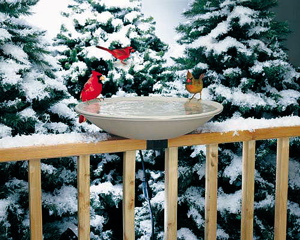-
Hummingbird Feeders Seeing Triple Activity
After switching from commercial nectar to the plain sugar-water solution, we’ve seen three times as many hummingbirds as before. For some reason, they seem to prefer the home made version with no additives better than packaged nectar products.
Sometimes you have to look closely to see the liquid level in the clear glass hummingbird feeders, and folks always say “shouldn’t it be red?” but the hummingbirds just know. Even though the the glass and the nectar are clear in color, hummingbirds flock to these feeders now. Four feeders are emptied almost daily, and it’s always a site to behold… for sure!
Making your own nectar is so simple too. One cup plain table sugar to four cups of water – that’s it. No need to boil the water, but it does help to dissolve the sugar quicker and more thoroughly. Any microorganisms are actually spread by hummers themselves, as they are carried on their bills. Never use anything but pure cane sugar (white table sugar) as it’s harmful to the birds and may be fatal.
The other great hummingbird enticer is leaf misters. They love to flit back and forth in the gentle mist. Any moving water will attract hummingbirds, especially a fountain added to your birdbath.
Try your own nectar and notice the difference in hummingbird activity at your place…Happy Birding!
-
Heated Bird Baths Do The Trick!
An investment in a birdbath is well worth the visitors it will bring to your yard. If you’re thinking of a new one to replace the old chipped concrete one …or even your first one…consider heated bird baths if your winters are freezing. Just as important in sweltering summer heat, a constant fresh water source is crucial to birds when temperatures freeze. Many folks believe birds eat snow for water (and they can) but it’s very difficult for them to metabolize and burns precious calories needed to stay warm. Shallow ponds will also tend to freeze over when temperatures drop below 32 degrees, and this renders a consistent and reliable water source useless for birds.
Remember, the heater does not need to run to use the bath year-round. In our yard there are 3 heated bird baths running throughout winter. This is part of the reason our bluebirds stuck around all year. Likely it was the live meal worms that were the big attraction, but these baths ensured fresh water daily regardless of the weather.
-
Federal Judge Halts Interior Department Wild Horse Roundup
Deadly Nevada Roundup Kills 12 Mustangs Due to Desert Summer Conditions and Roundup-related Injuries
Reno, Nevada (July 14, 2010) — Today at 5 p.m., Judge Larry R. Hicks of the U.S. District Court for the District of Nevada issued a restraining order against the Department of Interior stating that “defendants are prohibited from carrying out the gathering of any wild horses from within the Owyhee, Rock Creek and Little Humboldt Herd Management Areas in the northwest of Elko County, Nevada, until further order of the court.” A hearing is scheduled for tomorrow, Thursday July 15 at 2:30 p.m.
On July 13, plaintiff Laura Leigh, a Nevada writer and artist, filed a motion for a temporary restraining order (TRO) seeking an injunction to prevent the Interior Department’s Bureau of Land Management (BLM) from carrying out the roundup of wild horses in the Owyhee Complex. At an initial July 13 hearing, BLM explained that the gather was previously scheduled and had been postponed to, at the earliest, Sunday July 18.
On the basis of this representation the court scheduled a hearing on Ms. Leigh’s motion for July 15. Today, July 14, at 2:30 p.m., the court was informed that the director of the BLM, Bob Abbey, had authorized an emergency gather of horses to begin at 6 a.m. on Thursday July 15, prior to the court’s scheduled hearing.
Judge Hicks wrote: “Based on this change in the BLM’s position, the court finds it necessary to grant an immediate injunction preventing the Tuscarora gathering of wild horses until further order by the court.”
On Saturday, July 10, 2010, the BLM captured 228 horses in the Tuscarora roundup. The majority of these mustangs — including newborn and young, vulnerable foals were stampeded for eight miles over rugged terrain in summer desert conditions.
BLM reports that the majority of horses were in “good condition.” At least 12 mustangs — averaging under 5 years of age — have died so far, including seven who suffered gruesome deaths in the first 24-hours from dehydration-related causes, including colic, brain swelling and “water intoxication,” which happens when dehydrated horses drink too much water. Another horse was shot to death at the trap site after breaking his leg. Three colts, aged 2 – 4 months, are also among the victims.
The BLM proceeded with the summer roundup despite Ms. Leigh’s lawsuit and a pending legal action filed by Advocates for the West, a public interest law firm, on behalf of In Defense of Animals, both of which warned of danger to the horses of a roundup in the summer heat and so close to foaling season. Ms. Leigh’s lawsuit addresses the removal of the wild horses and the BLM’s violation of her First Amendment rights by prohibiting her from observing and videotaping the roundup operations.
The BLM plans to remove approximately 1200 wild horses, leaving behind just 337 wild horses in the 500,000-acre Owyhee public lands complex.


